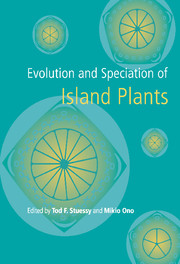Book contents
- Frontmatter
- Contents
- List of contributors
- Preface
- Acknowledgements
- Part one Hawaiian Islands
- Part two Juan Fernandez Islands
- Part three Southern and western Pacific Islands
- Introduction
- 6 Genetic diversity of the endemic plants of Bonin (Ogasawara) Islands
- 7 Evolution of cryptic dioecy in Callicarpa (Verbenaceae) on the Bonin Islands
- 8 Conservation of the endemic vascular plant species of the Bonin (Ogasawara) Islands
- 9 Preliminary observations on the evolution of endemic angiosperms of Ullung Island, Korea
- 10 Evolution in Crossostylis (Rhizophoraceae) on the South Pacific Islands
- Part four General evolutionary patterns and processes on oceanic islands
- Author index
- Taxon index
- Subject index
6 - Genetic diversity of the endemic plants of Bonin (Ogasawara) Islands
Published online by Cambridge University Press: 04 May 2010
- Frontmatter
- Contents
- List of contributors
- Preface
- Acknowledgements
- Part one Hawaiian Islands
- Part two Juan Fernandez Islands
- Part three Southern and western Pacific Islands
- Introduction
- 6 Genetic diversity of the endemic plants of Bonin (Ogasawara) Islands
- 7 Evolution of cryptic dioecy in Callicarpa (Verbenaceae) on the Bonin Islands
- 8 Conservation of the endemic vascular plant species of the Bonin (Ogasawara) Islands
- 9 Preliminary observations on the evolution of endemic angiosperms of Ullung Island, Korea
- 10 Evolution in Crossostylis (Rhizophoraceae) on the South Pacific Islands
- Part four General evolutionary patterns and processes on oceanic islands
- Author index
- Taxon index
- Subject index
Summary
Abstract
In this chapter we report the results of studies of genetic diversity of plants on the Bonin Islands, which are oceanic islands in the western Pacific, and compare these results with previous studies in other oceanic archipelagoes.
Oceanic island endemics have lowered genetic diversity in comparison with continental taxa. In populations of endemic plants on the Bonin Islands, low genetic diversity is also observed, and population size and heterozygosity are highly correlated.
In plants of the Bonin Islands, some genera show adaptive radiation. We have studied electrophoretically genetic divergence among these taxa. High genetic identities were observed in Pittosporum and in some species pairs of both Crepidiastrum and Symplocos. This result indicates low genetic differentiation among species in spite of their morphological divergence.
All the endemic plants now found on the Bonin Islands are descendants of progenitors that were immigrants in the past and these lineages have been isolated from original ancestral populations. Average genetic identities between the endemics and mainland species are comparable to those between congeneric species (0.63), as estimated by Crawford (1983). We have estimated divergence time of these endemic lineages from ancestral source populations to be 2.25 million years for Pittosporum, 3.15 million years for Crepidiastrum and 2.10 million years for Symplocos. On the other hand, preliminary data of widespread plants show relatively high genetic identity between insular and mainland populations.
Several studies have measured the genetic diversity of endemic plants on oceanic islands, such as on the Hawaiian Islands (Lowrey & Crawford, 1985; Helenurm & Ganders, 1985; Witter & Carr, 1988), the Juan Fernandez Islands (Crawford et al., 1987a, 1992) and the Galapagos Islands (Wendel & Percival, 1990).
- Type
- Chapter
- Information
- Evolution and Speciation of Island Plants , pp. 141 - 154Publisher: Cambridge University PressPrint publication year: 1998
- 11
- Cited by



